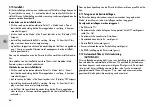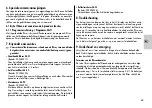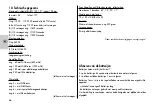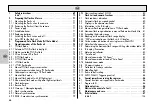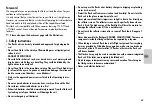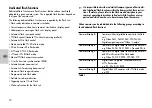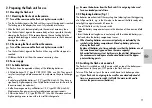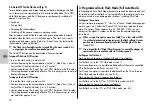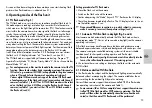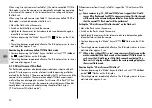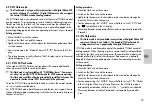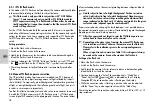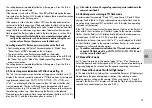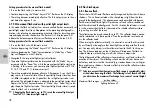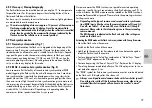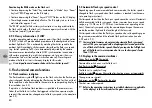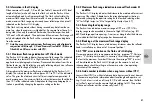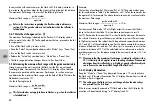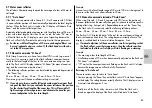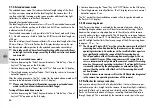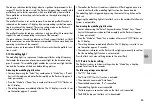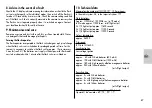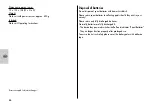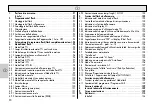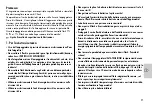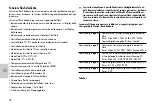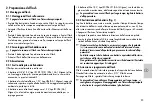
78
ķ
Setting procedure for the manual flash mode M
• Turn on the flash unit by its main switch.
• Continue depressing the “Mode” key until “M” flashes on the LC display.
• The setting becomes immediately effective. The LC display returns to its nor-
mal state after approx. 5 sec.
4.7.2 MLo manual flash mode with partial light output levels
In this mode the flash unit always fires an uncontrolled flash at a manually set
partial light output level (Low). Adaptation to the prevailing photographic s-
ituation is by selecting an appropriate partial output level or by setting a cor-
responding aperture on the camera. The flash unit’s LC display panel will
indicate the distance required for correct flash exposure (also see 5.4.2).
Setting procedure for the manual flash mode MLo
• Turn on the flash unit with the main switch.
• Continue depressing the “Mode” key until “M” flashes on the LC display.
• Continue depressing the “Select” key combination (= “Mode” key + “Zoom”
key) until
P
appears on the LC display.
• Alongside
P
, the set partial light output value flashes.
• The partial light output level can be diminished with the “Mode” key, or
increased with the “Zoom” key, while the manual partial light output value
is flashing. In this manner, you can set partial light output values of P 1/8 ,
P 1/4, P 1/2 and P 1/1 (maximum output).
• The setting immediately becomes effective. After approx. 5 sec. the LC dis-
play returns to its normal state. When the partial light output level has been
set ,
MLo
is displayed on the LC panel but the set light output value is not
indicated. The indicated distance is adapted to the partial light output level.
Depress the “Select” key combination (= “Mode” key + “Zoom” key) to dis-
play the partial light output value. The set partial light output level is saved
when the flash unit is switched off.
Changing the flash mode, e.g. to TTL, resets the manual light output
level to P 1/1 (maximum light output).
☞
4.8 Flash techniques
4.8.1 Bounce flash
Photos shot with full frontal flash are easily recognized by their harsh, dense
shadows. This is often associated with a sharp drop in light from the fore-
ground to the background. This phenomenon can be avoided with bounce
flash because the diffused light will produce a soft and uniform rendition of
both the subject and the background. For this situation the reflector is turned
in such a manner that the flash is bounced off a suitable reflective surface
(e.g. ceiling or wall of the room).
The reflector can be turned vertically up to 90°. The reflector head is mecha-
nically interlocked in its basic position. Press the pushbutton to unlock and
turn the reflector head.
When turning the reflector vertically, it is essential to ensure that it is moved
by a sufficiently wide angle so that direct light can no longer fall on the sub-
ject. Consequently, always turn the reflector at least to the 60° lock-in posi-
tion. The distance readings on the LC display will disappear. The flash-to-
subject distance via the ceiling or wall is an unknown magnitude.
The light bounced off the reflecting surfaces produces a soft and uniform illu-
mination of the subject. The reflecting surface must be white or have a neu-
tral colour, and it must not be structured (e.g. wooden beams in a ceiling) as
these might cause shadows. For colour effects just select the reflective surface
in the desired colour.
Take into account that the maximum flash range is considerably dimi-
nished when bouncing the flash. The following rule of thumb will help
you determine the maximum flash range for a room of normal height:
guide number
Maximum flash range = —————————————
lighting distance x 2
☞
Summary of Contents for MECABLITZ 54 AF-1 N
Page 45: ...45 ĸ ...
Page 67: ...67 ń ...
Page 89: ...89 ķ ...
Page 111: ...111 ƴ ...
Page 141: ...141 ...

